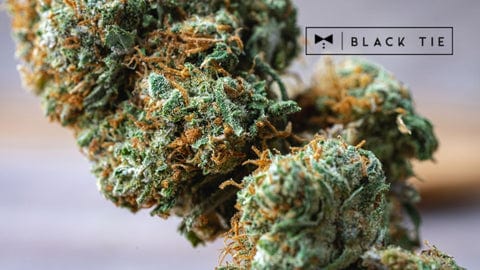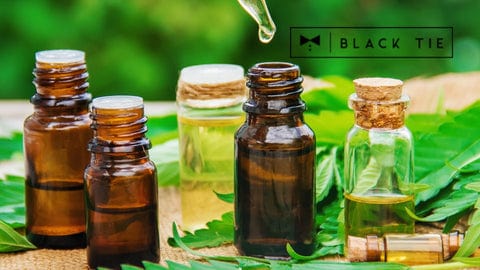THCA flower is changing how Americans experience cannabis—legally. It offers real effects with federal protection under the 2018 Farm Bill. In states without recreational marijuana, THCA flower has become the most powerful alternative. When heated, it becomes Delta-9 THC. This means smoking or vaping THCA gives you the same effects as traditional weed. But it’s technically legal—if sourced from compliant hemp.
At Black Tie CBD, we specialize in premium THCA hemp flower. Our flower is tested, clean, and grown indoors for quality. We offer award-winning strains, 30g ounces, and no excise tax. Plus, free shipping on orders over $100 and a 30-day satisfaction guarantee.
Let’s explore what THCA flower really is—and how to use it safely and effectively in 2025.
What Is THCA Flower?
THCA stands for tetrahydrocannabinolic acid. It’s the raw form of THC found in unheated cannabis and hemp. In its natural state, THCA is non-psychoactive. That means it won’t get you high unless it’s heated. When you smoke, vape, or bake THCA flower, it converts to Delta-9 THC. This process is called decarboxylation. That’s what makes THCA flower so exciting. You get all the benefits of marijuana—without violating federal hemp laws.
THCA flower looks and smells like weed. But it contains less than 0.3% Delta-9 THC before heating. That makes it legal to ship.
At Black Tie, we sell indoor-grown THCA flower that’s COA-verified and strain-specific. Each batch is tested for safety and compliance. This ensures you’re getting a clean, consistent, and federally legal experience with every puff.
How Is THCA Flower Made?
Creating high-quality THCA flower starts with the genetics. The plant must be bred for high THCA and low Delta-9 THC. Growers then cultivate the plant using indoor methods. This gives more control over light, airflow, and nutrients. At harvest, the flower is trimmed and slowly cured. This process locks in potency and preserves terpenes.
Curing also helps maintain the THCA in its acidic, non-psychoactive form until the user heats it. Once dried, the flower is lab-tested for THCA percentage and Delta-9 THC levels. Only batches under 0.3% Delta-9 pass compliance. Black Tie’s THCA flower is grown indoors, never infused or sprayed. Our strains are bred for natural potency and flavor.
We test every batch with third-party labs. These COAs confirm cannabinoid content and legal compliance. This means the THCA flower you receive from us is safe, federally legal, and packed with therapeutic potential.
Why Choose Black Tie for THCA Flower?
Not all THCA is equal. Many brands cut corners on growing, trimming, or testing. That’s where we stand apart. Black Tie only sells indoor-grown, non-infused THCA flower. Our buds are trimmed by hand, slow-cured, and terpene-rich. Each strain is selected for potency, flavor, and effect. From Lemon Cherry Gelato to Fruity Loops—we have a full genetic library.
We ship 30g ounces, not 28g, and never charge excise tax. That gives you more value and zero surprises at checkout.
Every flower product comes with a COA. These reports confirm that your flower is compliant and cannabinoid-rich. We also include usage guidelines so customers can enjoy each strain safely and effectively.
Top 5 Ways to Use THCA Flower
1. Smoking (Joints, Pipes, or Bongs)
Smoking is the most common way to use THCA flower. It instantly decarbs THCA into Delta-9 THC for fast, strong effects.
Roll your THCA flower into joints, load it into a glass pipe, or smoke it through a bong. This method gives you a full terpene profile. It also delivers the fastest onset of euphoria and body effects. Perfect for those who want classic cannabis-like experiences without legal risks.
2. Dry Herb Vaping
Dry herb vaporizers heat the flower without burning it. This method produces clean vapor and preserves delicate terpenes. It’s ideal for people with sensitive lungs or those who prefer smoother inhales.
Vaping THCA flower gives you rich flavor and controlled decarboxylation without combustion. It’s also more discreet—less smell, less irritation, and more efficiency per gram.
3. Decarbing THCA Flower for Edibles
To make edibles, you must first decarb THCA flower in the oven. Heating it activates the cannabinoids. Once decarbed, you can infuse it into butter, oil, or honey. Then use it in any recipe you like. This method gives longer-lasting effects. It’s great for those who prefer not to smoke or vape.
4. Glass Chillums or One-Hitters
For microdosing or discretion, one-hitters are a great choice. You use just a pinch of flower and get fast results.
Chillums offer a quick, pocket-sized way to enjoy THCA without rolling or vaping.
These tools are perfect for low-dose sessions or sampling new strains. They also help stretch your stash longer—ideal for daily users.
5. Mixing with CBD Flower
Want a more balanced experience? Blend your THCA flower with CBD-rich flower.
CBD can smooth out the high, reduce anxiety, and extend the session.
This mix offers an enhanced entourage effect—more cannabinoids working together for a fuller result.
It’s also a good method for newer users who want to ease into stronger effects.
Is THCA Flower Safe to Smoke?
Yes—if it’s clean, lab-tested, and sourced from a reputable vendor like Black Tie. THCA is not harmful in its raw form. When heated, it becomes THC—but it’s still safe to inhale in moderation. Just like traditional cannabis, smoke can irritate the lungs. Use glass, avoid combustion buildup, and stay hydrated. For more information visit our recent blog on, “Is THCA Safe Smoke?”
Always check COAs before buying. Never use untested or questionable flower. Black Tie’s THCA flower is third-party tested and grown indoors to eliminate contamination risk. We never spray, infuse, or artificially boost potency. What you see is what you smoke.
Is THCA Flower the Same as Weed?
It’s nearly identical—in every way that matters—once you heat it.
THCA flower looks, smells, and feels like marijuana. But it stays legal because it tests under 0.3% Delta-9 THC by dry weight. Once you apply heat, THCA becomes Delta-9 THC. That’s the same compound found in recreational cannabis.
So yes, it gets you high—just like weed. The difference is legal classification and source (hemp vs. marijuana). At Black Tie, we grow our flower to meet the same standards you’d expect from a top-shelf dispensary. Our strains offer real effects, stunning appearance, and exceptional terpenes—without the legal risk or retail taxes.
Does THCA Flower Smell Like Weed?
Yes. If you open a jar of Black Tie’s Lemon Cherry Gelato or Critical Mass—you’ll know it instantly. THCA flower is real cannabis in every way except for its Delta-9 content before heating. It carries the same terpenes, flavonoids, and aromas as traditional weed.
Depending on the strain, you may smell citrus, fuel, berries, skunk, or sweet pastry notes. The scent is potent—especially when fresh and properly cured, as all Black Tie strains are. If you're trying to stay discreet, store your flower in an airtight container. Use smoke filters or vapes for lower odor output.
Can I Legally Order THCA Flower Online?
Yes. THCA flower is federally legal to ship—if it’s derived from hemp and contains less than 0.3% Delta-9 THC by dry weight. That’s why Black Tie runs full-panel compliance testing on every batch. We ensure legal thresholds are never exceeded.
Our products come with Certificates of Analysis (COAs), confirming they’re Farm Bill–compliant and safe to ship nationwide.
However, laws can vary by state. Some states have introduced restrictions on smokable hemp or high-THCA products. Always check your local laws before ordering. At Black Tie, we also monitor legal updates to ensure safe shipping practices. If your state allows it, your THCA flower will arrive discreetly, promptly, and legally—via USPS Priority Mail.
Does THCA Flower Get You High?
Yes. Once heated, THCA turns into Delta-9 THC, the active cannabinoid responsible for the cannabis “high.” Smoking, vaping, or baking THCA activates it. The result is nearly identical to traditional marijuana effects.
Users report classic euphoria, uplifted mood, sensory enhancement, and appetite stimulation—depending on the strain. THCA flower won’t get you high if eaten raw. Only decarboxylation (heating) converts it into psychoactive form.
So yes—if you’re wondering whether THCA flower gets you high like weed: absolutely. It’s cannabis—just classified under hemp law.
How to Decarboxylate THCA Flower Properly
Decarbing THCA is easy. You just need an oven, a tray, and some parchment paper.
Step-by-Step Guide:
1. Preheat oven to 220–240°F (105–115°C)
2. Break your THCA flower into small pieces
3. Place on parchment-lined baking tray
4. Bake for 30–40 minutes
5. Let it cool completely before using
This low, slow heat breaks off the acid (the “A”) in THCA and converts it to active Delta-9 THC.
Once decarbed, your flower is ready for infusion into oil, butter, tinctures, or capsules.
Store decarbed flower in an airtight jar in a cool, dark place for best potency.
🔥 Important: Don’t rush or overheat. Going too hot will burn cannabinoids and reduce potency.
FAQs About THCA Flower
Is THCA flower legal in all 50 states?
No. While it’s federally legal, some states restrict high-THCA hemp products. Always verify your local laws before ordering.
Is THCA flower stronger than Delta-8?
Yes. THCA converts to Delta-9 THC, which is more potent than Delta-8 THC. Expect stronger mental and physical effects.
How much THCA flower should I use?
Start small. One to two puffs is plenty for new users. Always wait 10–15 minutes before taking more.
What’s the best way to store THCA flower?
Keep it in a sealed jar, away from light and heat. This protects terpenes and potency for months.
Does THCA flower expire?
Not exactly. But potency and flavor degrade over time. Use within 6–12 months for best results.
Can I travel with THCA flower?
Within legal states—yes. Always keep it in original packaging with COA proof. Avoid carrying it across state lines.
Final Verdict: THCA Flower Is the Future of Legal Cannabis
THCA flower bridges the gap between traditional cannabis and federally legal hemp. It offers real effects, fast relief, and legal access.
With the right source, it’s safe, clean, and reliable—whether you smoke, vape, or cook with it.
At Black Tie, we offer the best THCA flower online—indoor-grown, lab-tested, terpene-rich, and shipped discreetly nationwide.
From Lemon Cherry Gelato to Critical Mass, our strains deliver award-winning quality and serious potency.
If you’re ready to explore legal cannabis without compromise, THCA flower is your next step.
And Black Tie is your trusted source.
Learn how to smoke, vape, and decarb THCA flower for best results. Legal, potent, and safe—expert tips from Black Tie CBD for 2025 users.














